June 5, 2016
I wake this morning to an overcast sky and a sense of excitement. After several days of exploring Puerto Ayora, we’re heading out on a bay tour. We’ll finally get out on the water, and we’ll see sea lions and sharks, maybe even a sea turtle or two, and finish at Las Grietas, a stunningly pretty ocean water ravine.
As on most mornings, I read my email as I’m lying in bed preparing for the day. My excitement is swamped by a flood of sorrow: one of my chorus friends isn’t able to undergo chemo and has gone into hospice. The rush of aliveness I feel at exploring new places throws a sharp contrast against the realization that I will never see this friend again.
It’s a good thing my friend Maureen is with me, as she lets me talk all the way down to the ferry docks. In a weird way, I’m determined to enjoy today even more than I might have otherwise.
We arrive just after 8:00 am at the docks. The tide is out, and the water is incredibly calm.
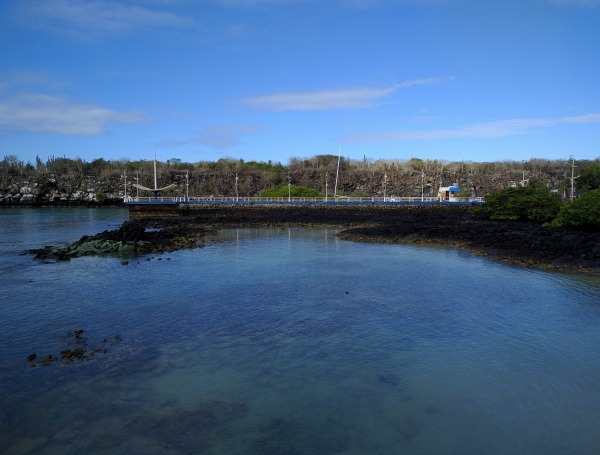
Booking our tour takes no time at all, leaving us a good 45 minutes before our 9:00 am departure time. I am grateful for the moments alone to lean on the dock wall and enjoy the early morning hustle.
A steady trickle of people are making their way onto the docks and hailing water taxis.
One by one the taxis peel away from the floating flotilla and approach the jetty. They come in nose-first, and their intrepid passengers step from jetty to boat with as much grace as they can.
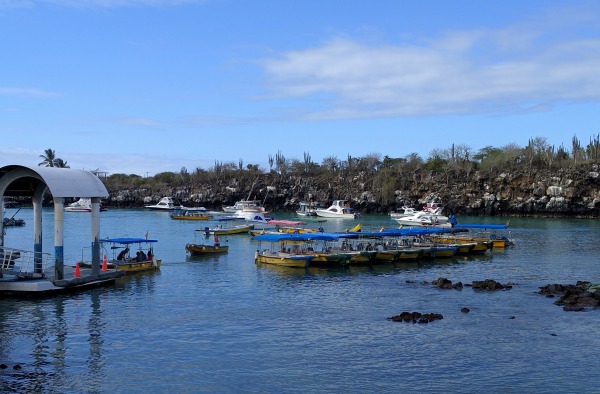
Luckily, our boat comes right to the jetty, no water taxi required. There’s about a dozen people in our group. Nearly everyone but me understands Spanish well enough to follow our guide. He speaks in Spanish first, then English. His English is hard to understand – he doesn’t pause between words and they slur together in his Spanish accent.
It feels good to be out on the water, an ocean breeze in my face and the land receding behind us.
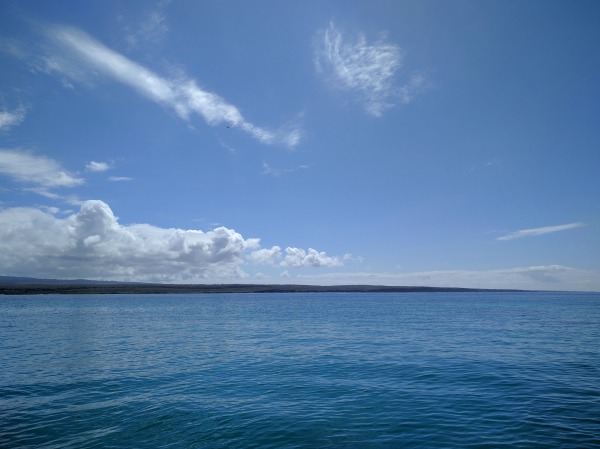
Our first stop is a spot offshore where white-tipped sharks are known to hang out. For a few minutes there’s nothing but the slap of the waves against the boat. Then, a dark shape moves through the water below us. It’s a shark!
It’s hard to get a clear view, but even the grey shape moving below the water is enough to get my heart beating faster. Even though I know most sharks don’t eat humans, they are all predator and I can’t help wanting to give them a wide berth.
Once we’ve all seen the sharks, the captain fires up the motor and takes us to Isla Caamano, a small island at the mouth of Academy Bay. Strong currents make it impossible to land on the island, so we anchor offshore.
Up in the rocks we see our first bird: a nasca boobie. Our guide assures us it’s good luck to see one so early in the trip. It’s hard to know whether that’s the truth, or just something that sounds good to tourists.
We’re admiring the rush of blue water against the black rocks, the red Sally Lightfoot crabs and the green algae, when a cry goes up from the right side of the boat. There’s a sea lion!
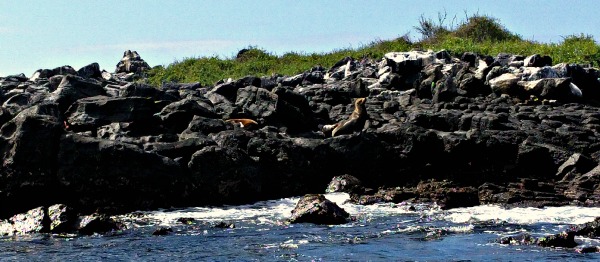
As we drift closer to that section of rocks, we see three sea lions: one sleeping on a rocky promontory just above the shore, and a mama with a young pup in tow.
The mom and pup wake up as we watch and begin to play in a channel of seawater coming in over the rocks. At times the incoming tide covers the pup completely, but it always resurfaces looking pleased with itself. Mom seems less impressed.
As both mother and pup fade from sight, we shake ourselves out of our sea lion reverie. Our next stop isn’t far, just to the far side of Franklin Bay. Here the water is shallow and clear; perfect for snorkeling.
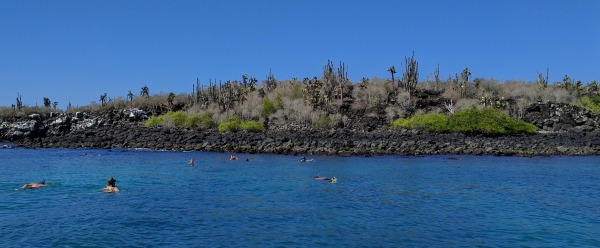
Most of our tour group happily strap on masks and fins and lower themselves into the cool water. Three of us remain on board the boat. It’s a gorgeous morning. The rock of the boat at anchor and the breeze in the shade of the boat canopy are a perfect way to enjoy the scenery.
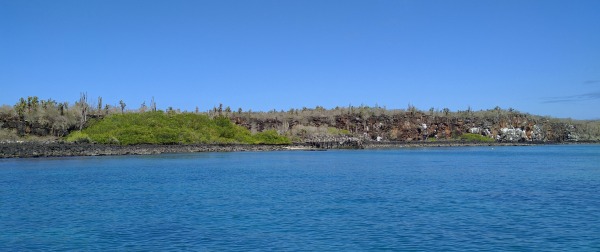
After twenty or thirty minutes, the snorklers come back to the boat. My friend Maureen is delighted: a sea lion swam under her and she was able to float right over the top of a sea turtle.
Our 4th and 5th stops actually involve getting off the boat. The sun is well up now, and the heat of stepping back onto dry land is palpable after the coolness of being on open water.
Before we can get onto the jetty, our guide has to chase away the sea lion that’s taken up residence. He or she doesn’t look too pleased with us, but we forget about it in the joy of watching another sea lion cavort in the shallows below us.
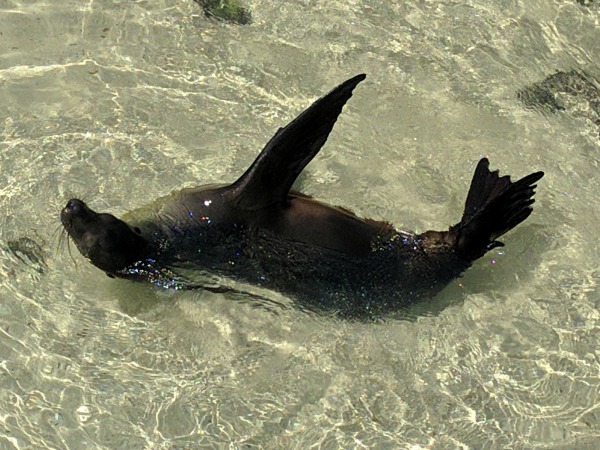
On our way across the jetty, our guide points out a dog crab below us on the rocks. It’s a pretty unremarkable crab, but it’s the first one I’ve seen that isn’t a Sally Lightfoot.
We’re properly on the trail now, which is a series of wooden steps climbing to the cliff top. Halfway up, we stop to appreciate the Love Canal.
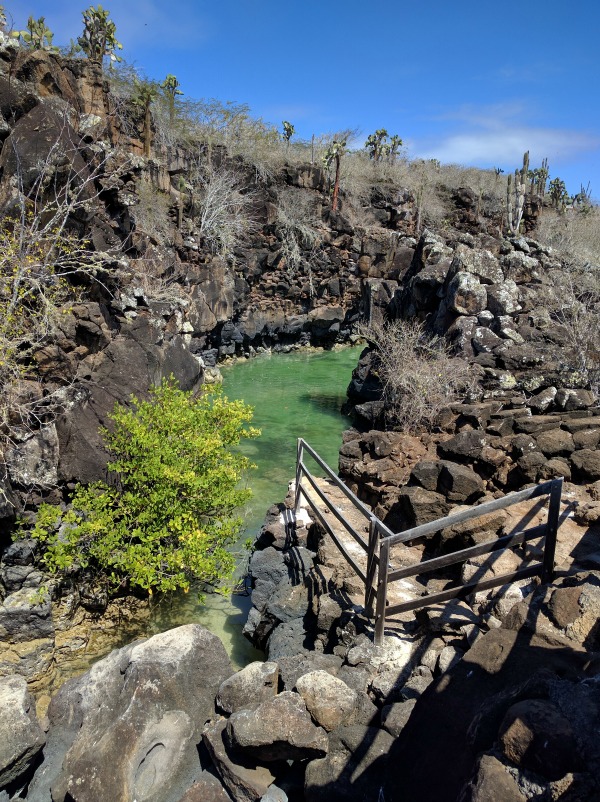
It’s a pretty place, narrow with only one way in or out. According to our guide, it’s so named because locals used to bring their boats here to make out. No one comes here anymore, though – I think it may actually be restricted, although there are no signs or anything marking it as such.
Once on the cliff top, we set off down a rocky path to another canal. This one is called Canal de las Tintoreras – Canal of the Sharks. The trail ends abruptly in a viewing cul-de-sac, and there 20 feet below us are a dozen or more white-tipped reef sharks.
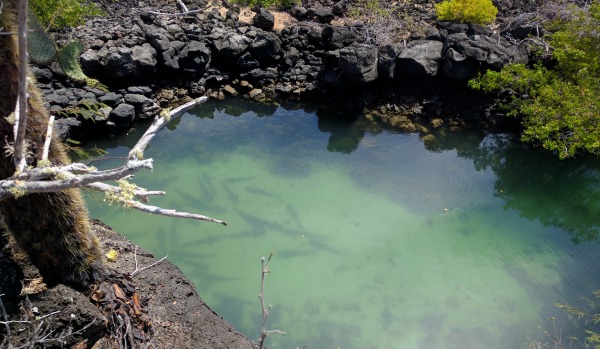
White-tipped reef sharks rest during the day and hunt at night. They’re a uniform grey color, except for the white tip on its main dorsal fin and the top fin on its tail. They mostly eat fish, octopi, and crustaceans, and can be found all around the Galapagos Islands.
There’s another tour group behind us, so our guide only allows us to gape for a few minutes before hustling us back onto the trail. This time we take the right fork at the clifftop and cut across the island.
We’re headed for Playa de los Perros, but the scenery we’re walking through has none of the grandeur of the love canal.
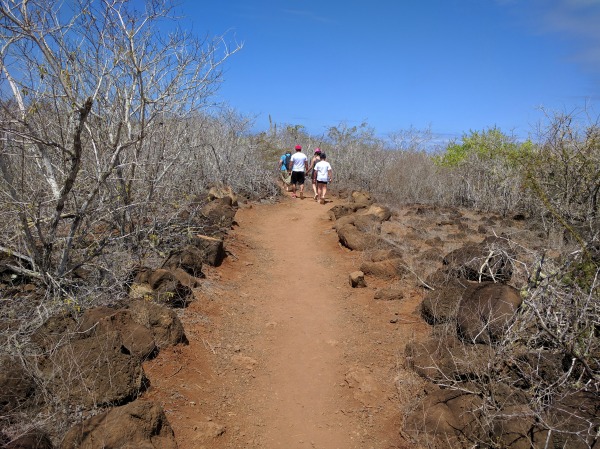
It’s hot on the island, and now that we’re away from the shore, there is absolutely no breeze. The hike takes perhaps five or ten minutes, but it seems to take a long time.
And when we do finally arrive at Playa de los Perros (Beach of the Dogs), the view is less than stunning.
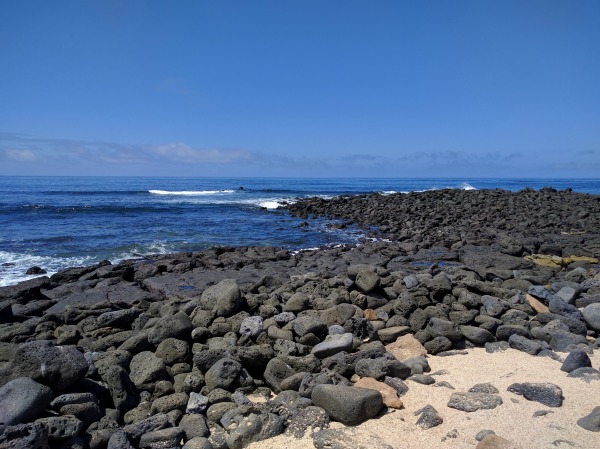
Like Tortuga Bay, which doesn’t have any turtles, Playa de los Perros doesn’t have any dog crabs. There used to be dog crabs here, but not anymore. The main attraction here are Sally Lightfoot crabs and black marine iguanas.
Having seen many of these over the last few days, Maureen and I pay no attention to the beach and instead marvel at the alien nature of the landscape.
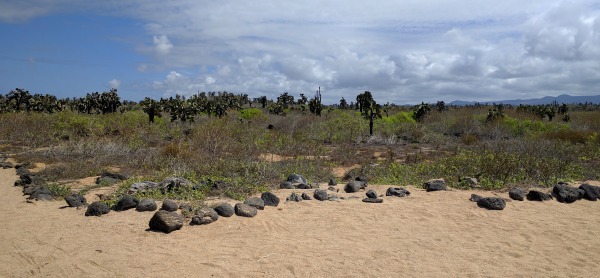
After a few minutes, we retrace our hot dusty steps and return to our boat. We have one final stop, and it is Las Grietas.
Getting to Las Grietas involves pulling up to yet another dock and hiking yet another hot dusty trail. We pass the Italian consulate on our left, round the corner, and there before us is the most amazing sight I’ve seen all day.
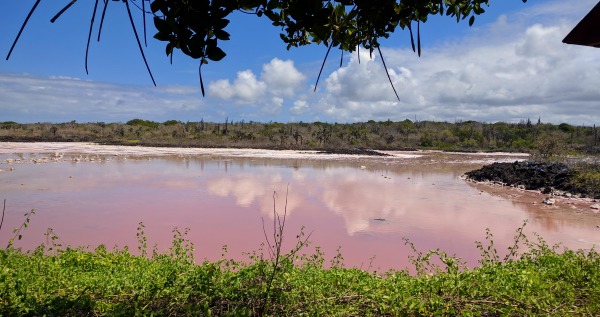
It’s a natural salt mine, and the pink of the salt water against the green foliage and blue sky is breathtaking.
I don’t know it at the time, but we’re here at the perfect time of day. A few days later we come back in the late afternoon, and the pink is all gone from the water. Something about the noon-day sun must bring out the pink hues.
Past the salt mine, the trail becomes quite rocky. We pass this saltwater slough that is so foreign to my Midwest and Pacific Northwest eyes that it’s easy to believe we’re on another planet entirely.
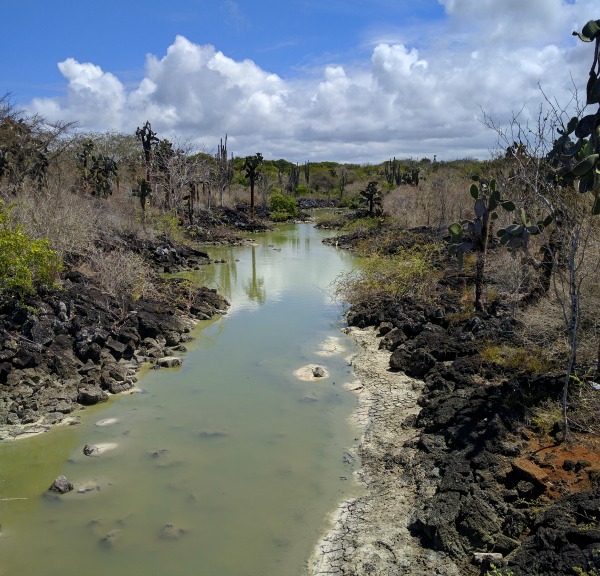
A few minutes later we pass a saltwater pond, with a special guest.
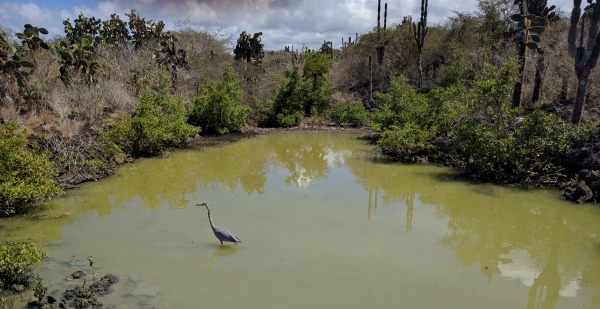
Finally, fifteen hot and sweaty minutes later, we arrive at Las Grietas.
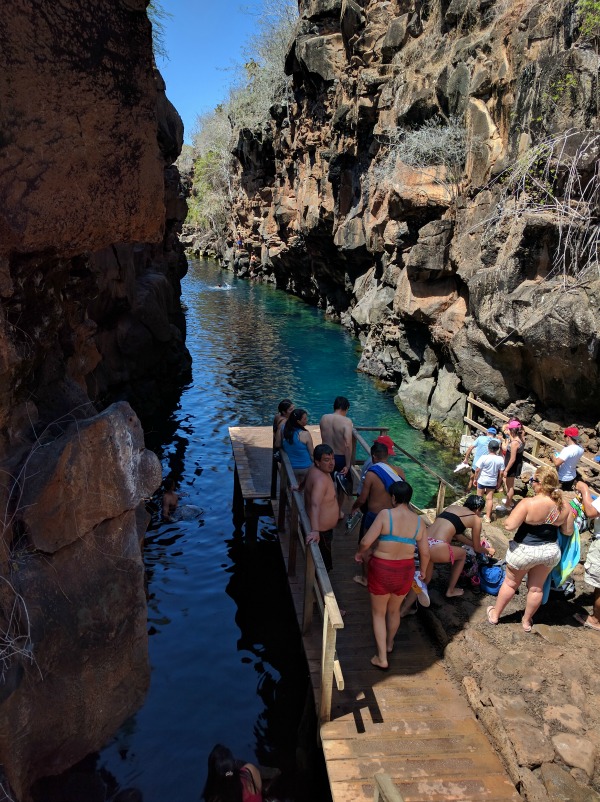
Las Grietas is a ravine filled amazingly clear cold ocean water. On a hot weekend day like today it’s crawling with people. Maureen plunges right in, while I find a spot on the rocks to dangle my feet. The water is cold, but after the long walk it feels great.
It’s a great place to people watch. Some visitors jump right in, doing cannon balls off the platform. Others ease themselves into the water inch by inch using the natural rock steps. Several have found the shallow rock under the platform and urge me to join them. I decline, but do strike up a conversation with two Australian gals about my age who give me some excellent advice about our upcoming trip to Isla Isabela.
Eventually my rocky perch becomes uncomfortable, and I hike up to the benches at the top of the ravine. Maureen is there before me, deep in conversation with a Chilean man who’s part of our tour group.
My grasp of Spanish isn’t great, but I manage to follow the gist of the conversation. He’s giving her suggestions on where to go in Chile, which areas are best for wine, and above all not to book a wine country tour in Buenos Aires because you never know quite what you’ll get.
All too soon, our guide recalls us to the tour boat. We hike back across the path through the saltwater sloughs, past the salt mine, and back onto our boat. It’s a very short trip back to the docks, but there’s one final surprise left.
As we climb onto the jetty back in town, we stumble over a pair of sea lions on the jetty. They are so close we could reach out and touch them. As we watch, the pup wakes up and begins nursing from its mother.
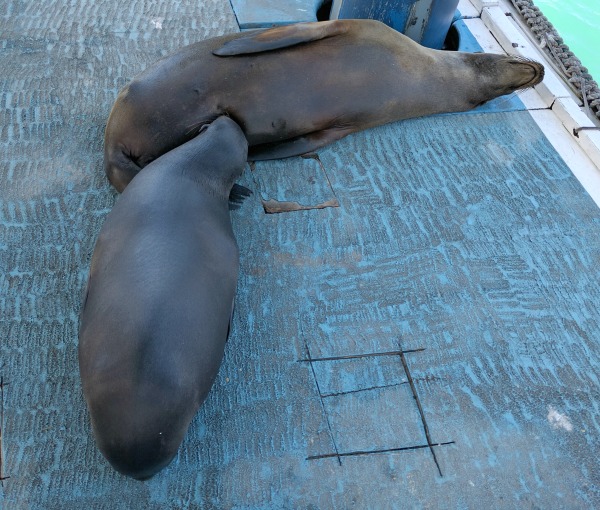
Most sea lions nurse 6 to 11 months. However, some Galapagos sea lions have been known to nurse up to three years!
It’s a fabulous end to our bay tour. Amazingly, the whole tour only took about 3 hours. We now have the entire afternoon and evening to ourselves.
Maureen opts to run some errands in town; I take a nap in our hammock. We keep our phone date with a friend of ours at 5, make dinner, and get ready to relocate to the second of our two rental houses tomorrow morning.
Just before bed, I check my Facebook feed. All over again, I’m hit by how lucky I am to have the chance to do what I’m doing right now, while I’m able, and not put it off. You just never know what life will throw at you or your loved ones.

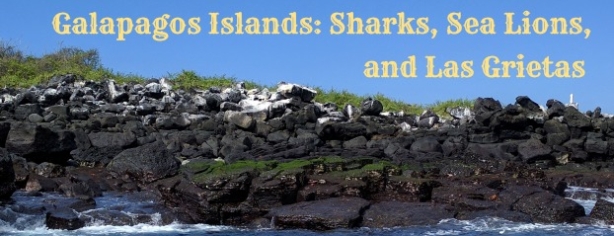









Quite the combination of landscape, sea life, and salt water features. Nice that the water was so calm; is that normal? Love the water shots.
It was normal for the time we were there, certainly! I’m not sure about year-round; I would imagine there is a windy and rainy period. Like Mom, I love being near or on the water, but feel little desire to actually get in the water. 😉